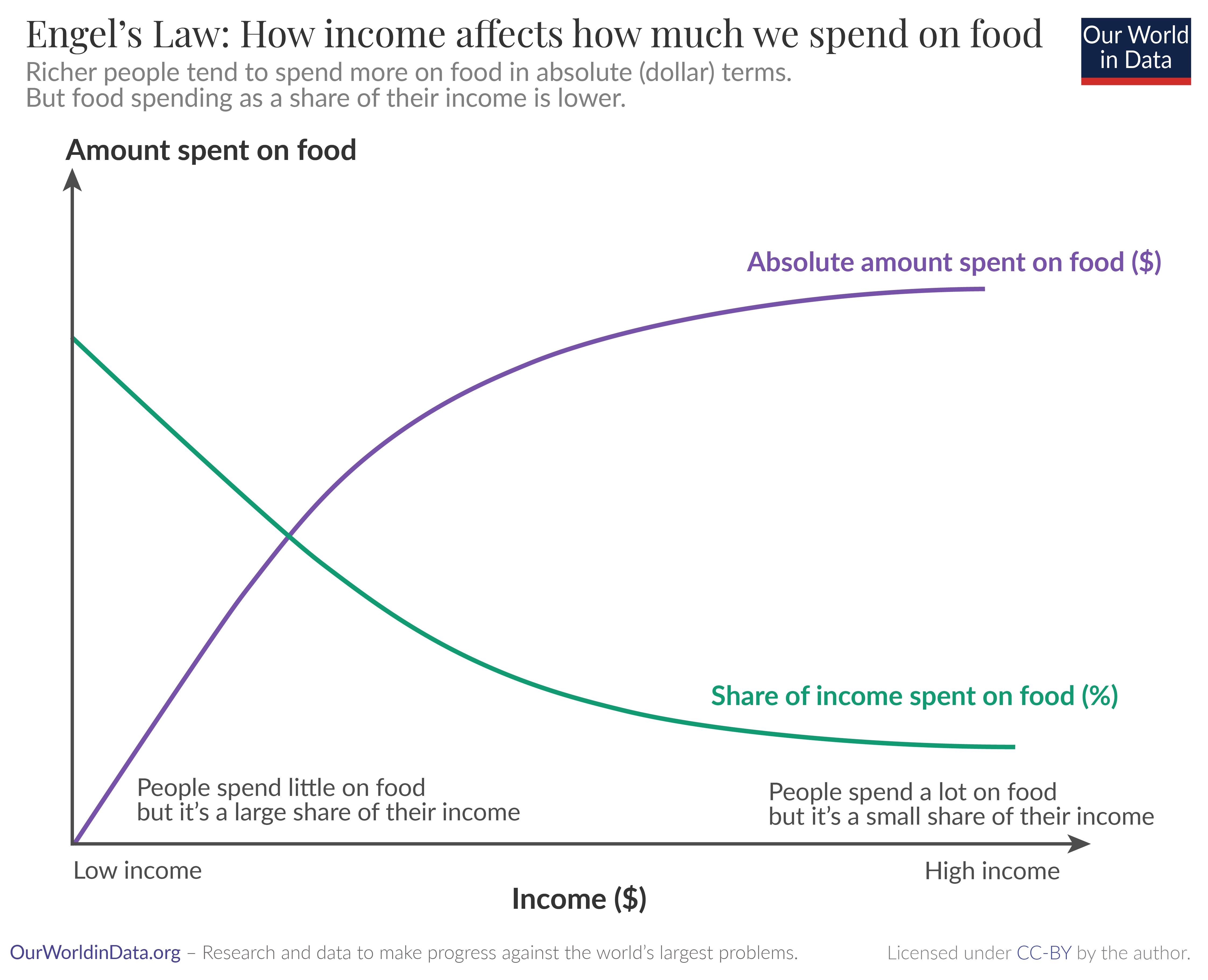Richer people tend to spend more money on food.
We see this relationship when we look at data on food expenditure from across the world.
In the chart you see food expenditure plotted against total consumer expenditure per person. Total consumer expenditure is any personal expenditure on goods and services.
On the y-axis, we have the average amount of money spent on food per person, in countries across the world.1 This measures money spent on food consumed at home – from stores and supermarkets. The source does not include food eaten out-of-home, from restaurants and cafes (however, that would be useful data to have). Tobacco and alcoholic beverages are also excluded.
On the x-axis, we have a measure of prosperity, total expenditure. Expenditure tells us how much disposable income people have to spend on goods and services such as food, housing, education, health, and leisure activities. It’s important to ensure that we can afford all of the essentials that give us a high and comfortable standard of living.
Countries which are poor – and where therefore people’s expenditure is very low – can be found, richer countries are further towards the right. This is shown on a log axis by default, but you can change it to a linear scale on the interactive chart.
Both metrics are measured in US dollars per person per year.
What we see is a strong positive relationship: where expenditures are high people tend to spend more money on food
At expenditures below $5,000, the average person tends to spend less than $1,000 on food. At expenditures above $10,000, it’s common for the average to be $2,000 or more per person per year.
For richer people, food makes up a smaller share of their expenditure
The amount of money spent on food might increase in absolute terms — as we saw in the previous chart — it falls as a share of people’s expenditure. This is what the following chart shows.
In the chart, we’ve plotted food spending against total expenditure again, but this time food spending is measured as a percentage of someone’s total expenditure.2
In countries with expenditures below $10,000, it’s common for people to spend a quarter or more on food.
As total spending rises, a smaller and smaller share goes toward food. At high expenditures, it’s common for people to spend 10% or less. This is despite the fact that they spend more on food in absolute terms.
Both of these points are positive signs for consumers. Spending more on food in dollar terms often means that people are eating more diverse diets. At low incomes, people tend to rely on cheaper staple crops such as cereals and tubers for most of their calories. As people get richer they can afford other foods such as fruits, vegetables, legumes, meats, and dairy products which have a wider range of micronutrients, protein, and fats.
Spending less of our money on food means we have more disposable income for other essentials such as education, healthcare, and housing.
Engel’s Law: how food spending changes with income
That gives us two important insights into food spending.
First, richer people tend to spend more money on food in absolute terms. Second, food tends to account for a smaller percentage of their total expenditure.
The chart illustrates this relationship: in absolute terms spending on food increases with income (shown in purple), in percentage terms it decreases (shown in green).
Combine them and we get a relationship called ‘Engel’s Law’: as household income (and expenditure) increases, the percentage that is spent on food decreases, but the absolute amount spent on food increases.
Research has shown that this relationship holds true within countries: studies looking at household expenditures in South Africa and China, for example, found the same pattern.3

Keep reading at Our World in Data…
In a related article, I look at what happens at the bottom of the global income distribution: it’s estimated that around three billion people can’t afford a healthy, diverse diet even when they spend most (or all) of their income on food. We want them to be able to spend more on food so they can have a diversified diet, and we don’t want them to have to spend all of their money to achieve this.



